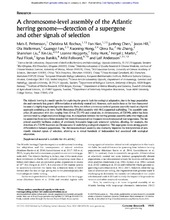| dc.contributor.author | Pettersson, Mats E. | |
| dc.contributor.author | Rochus, Christina M. | |
| dc.contributor.author | Han, Fan | |
| dc.contributor.author | Chen, Junfeng | |
| dc.contributor.author | Hill, Jason | |
| dc.contributor.author | Wallerman, Ola | |
| dc.contributor.author | Fan, Guangyi | |
| dc.contributor.author | Hong, Xiaoning | |
| dc.contributor.author | Xu, Qiwu | |
| dc.contributor.author | Zhang, He | |
| dc.contributor.author | Liu, Shanshan | |
| dc.contributor.author | Liu, Xin | |
| dc.contributor.author | Haggerty, Leanne | |
| dc.contributor.author | Hunt, Toby | |
| dc.contributor.author | Martin, Fergal J. | |
| dc.contributor.author | Flicek, Paul | |
| dc.contributor.author | Bunikis, Ignas | |
| dc.contributor.author | Folkvord, Arild | |
| dc.contributor.author | Andersson, Leif | |
| dc.date.accessioned | 2020-07-01T08:42:30Z | |
| dc.date.available | 2020-07-01T08:42:30Z | |
| dc.date.issued | 2019 | |
| dc.Published | Pettersson ME, Rochus, Han, Chen, Hill J, Wallerman, Fan G, Hong, Xu Q, Zhang H, Liu, Liu X, Haggerty, Hunt, Martin, Flicek P, Bunikis, Folkvord A, Andersson L. A chromosome-level assembly of the Atlantic herring genome-detection of a supergene and other signals of selection. Genome Research. 2019;29:1919-1928 | eng |
| dc.identifier.issn | 1549-5469 | en_US |
| dc.identifier.issn | 1088-9051 | en_US |
| dc.identifier.uri | https://hdl.handle.net/1956/23157 | |
| dc.description.abstract | The Atlantic herring is a model species for exploring the genetic basis for ecological adaptation, due to its huge population size and extremely low genetic differentiation at selectively neutral loci. However, such studies have so far been hampered because of a highly fragmented genome assembly. Here, we deliver a chromosome-level genome assembly based on a hybrid approach combining a de novo Pacific Biosciences (PacBio) assembly with Hi-C-supported scaffolding. The assembly comprises 26 autosomes with sizes ranging from 12.4 to 33.1 Mb and a total size, in chromosomes, of 726 Mb, which has been corroborated by a high-resolution linkage map. A comparison between the herring genome assembly with other high-quality assemblies from bony fishes revealed few inter-chromosomal but frequent intra-chromosomal rearrangements. The improved assembly facilitates analysis of previously intractable large-scale structural variation, allowing, for example, the detection of a 7.8-Mb inversion on Chromosome 12 underlying ecological adaptation. This supergene shows strong genetic differentiation between populations. The chromosome-based assembly also markedly improves the interpretation of previously detected signals of selection, allowing us to reveal hundreds of independent loci associated with ecological adaptation. | en_US |
| dc.language.iso | eng | eng |
| dc.publisher | Cold Spring Harbor Laboratory Press | en_US |
| dc.rights | Attribution-NonCommercial CC BY-NC | eng |
| dc.rights.uri | http://creativecommons.org/licenses/by-nc/4.0/ | eng |
| dc.title | A chromosome-level assembly of the Atlantic herring genome-detection of a supergene and other signals of selection | en_US |
| dc.type | Peer reviewed | |
| dc.type | Journal article | |
| dc.date.updated | 2020-01-03T13:09:51Z | |
| dc.description.version | publishedVersion | en_US |
| dc.rights.holder | Copyright 2019 The Author(s) | en_US |
| dc.identifier.doi | https://doi.org/10.1101/gr.253435.119 | |
| dc.identifier.cristin | 1762795 | |
| dc.source.journal | Genome Research | |

